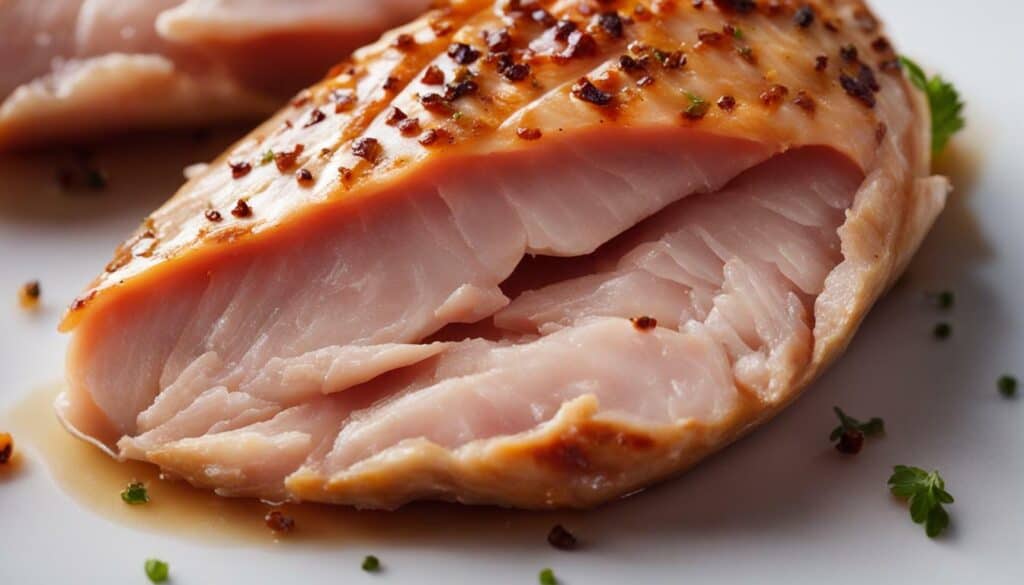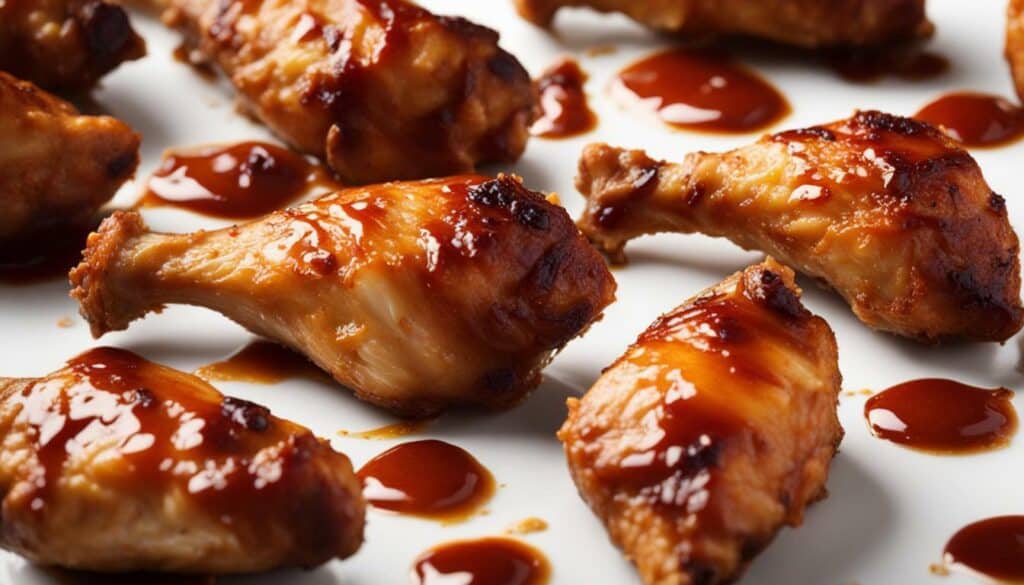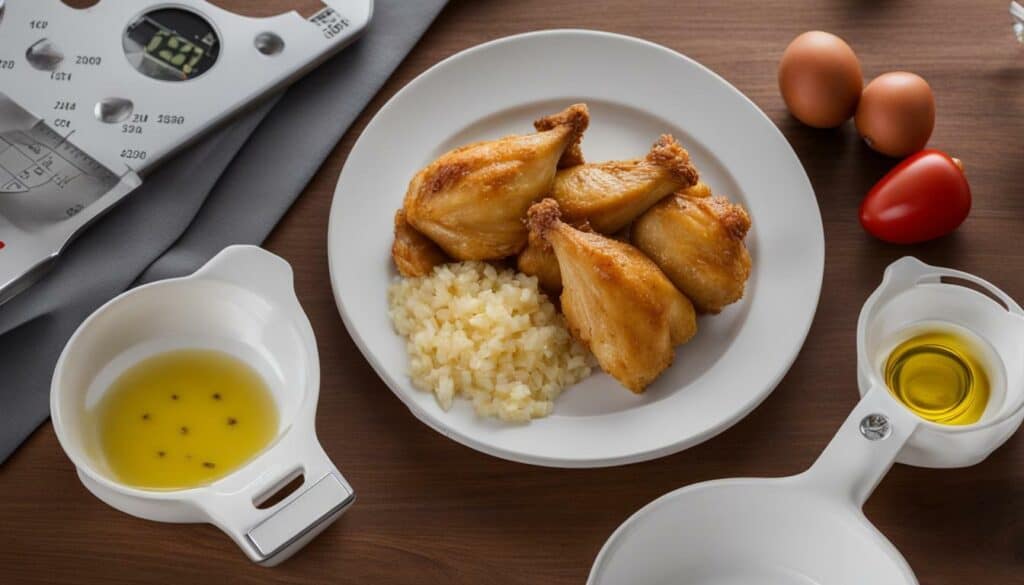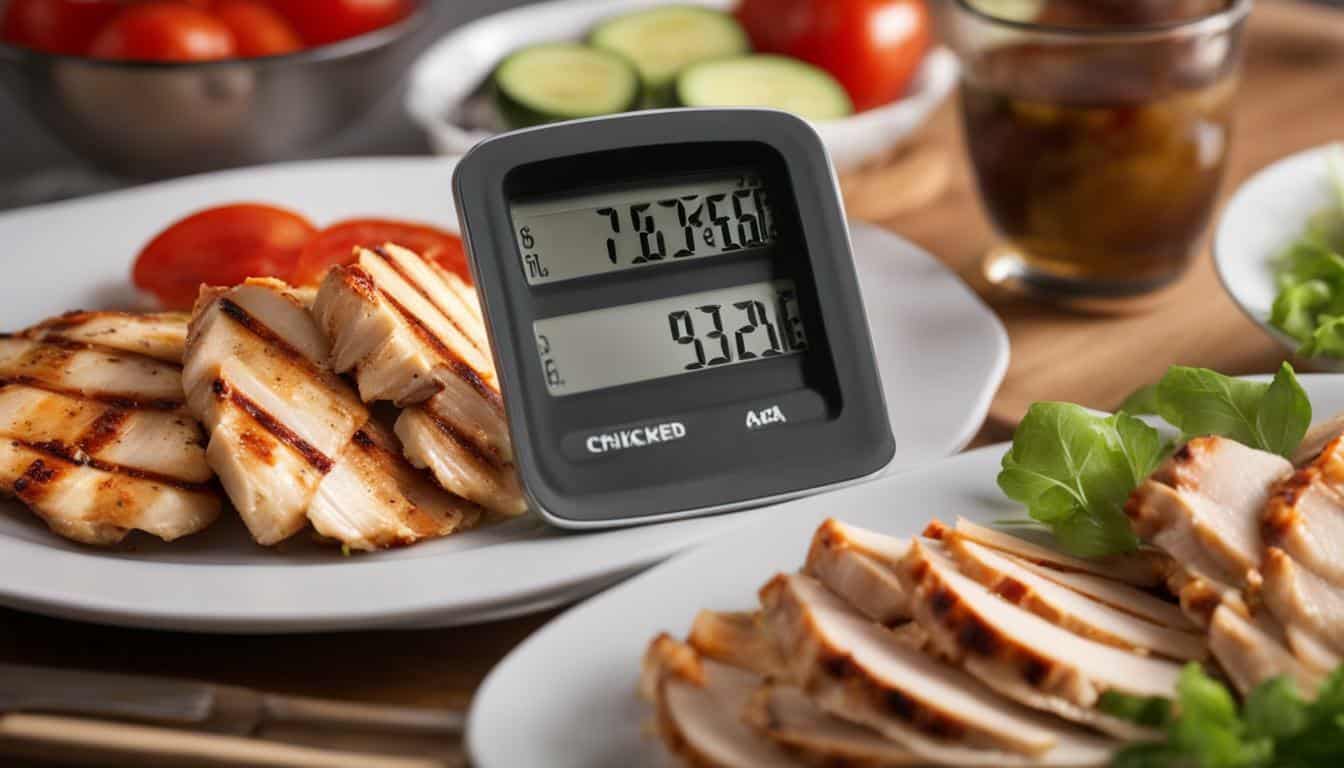If you’re curious about the calories in chicken slices, you’ve come to the right place. In this article, I will provide you with important nutrition facts to help you make mindful dietary choices. Whether you prefer boneless, skinless chicken breasts, flavorful drumsticks, or crispy chicken wings, understanding the calorie content of each cut can assist you in managing your calorie intake.
- Chicken breasts contain approximately 165 calories per 3.5-ounce serving, with boneless, skinless options being the leanest choice.
- Cooking chicken with the skin and bones increases the calorie count.
- Drumsticks and thighs have higher calorie content compared to chicken breasts.
- Removing the skin from drumsticks and thighs can significantly reduce calorie intake.
- Chicken wings have the highest calorie content among the cuts mentioned.
Understanding the Calorie Content of Chicken Breast Slices
Let’s start by examining the calorie content of chicken breast slices. When it comes to counting calories in chicken slices, the number will vary depending on the cut and preparation method. Chicken breasts are a popular choice, and it’s important to understand their nutritional profile in terms of calories, protein, fat, sodium, and iron.
A 3.5-ounce serving of boneless, skinless chicken breast contains approximately 165 calories, 31 grams of protein, 3.6 grams of fat, 74 milligrams of sodium, and 1 milligram of iron. It is a lean option with a good source of protein. However, it’s worth noting that if the breast is cooked with the skin and bones, the calorie count increases to about 197 calories, with 30 grams of protein and 7.8 grams of fat.
When making dietary choices, it’s important to consider portion sizes and cooking methods. Different cuts of chicken and the presence of skin can significantly impact the caloric value. For example, chicken drumsticks with the skin on have a higher calorie count compared to skinless chicken breasts. A 3.5-ounce serving of cooked drumstick with the skin on contains around 216 calories, 27 grams of protein, 11.2 grams of fat, 90 milligrams of sodium, and 1.3 milligrams of iron. Removing the skin reduces the calories to about 175 and the fat to 5.7 grams.
Additionally, chicken thighs have a higher calorie content compared to other cuts. A 3.5-ounce serving of cooked thighs with the skin on contains around 229 calories, 25 grams of protein, 15.5 grams of fat, 84 milligrams of sodium, and 1.3 milligrams of iron. Removing the skin reduces the calories to about 209 and the fat to 10.9 grams.
| Chicken Cuts | Calories (per 3.5 oz) | Protein (g) | Fat (g) | Sodium (mg) | Iron (mg) |
|---|---|---|---|---|---|
| Skinless Chicken Breast | 165 | 31 | 3.6 | 74 | 1 |
| Chicken Breast with Skin and Bones | 197 | 30 | 7.8 | N/A | N/A |
| Skin-on Drumstick (cooked) | 216 | 27 | 11.2 | 90 | 1.3 |
| Skinless Drumstick (cooked) | 175 | 27 | 5.7 | 90 | 1.3 |
| Skin-on Thigh (cooked) | 229 | 25 | 15.5 | 84 | 1.3 |
| Skinless Thigh (cooked) | 209 | 25 | 10.9 | 84 | 1.3 |
Lastly, chicken wings have the highest calorie content among common cuts. A 3.5-ounce serving of cooked wings with the skin on contains approximately 290 calories, 27 grams of protein, 19.5 grams of fat, 82 milligrams of sodium, and 1.3 milligrams of iron. Removing the skin reduces the calories to about 203 and the fat to 8.1 grams.
By understanding the calorie content of chicken slices and considering portion sizes and cooking methods, you can make informed choices that align with your dietary goals. For a lower calorie option, opt for skinless chicken breasts and be mindful of the nutritional profile when enjoying other cuts.
References:
- USDA Food Composition Databases. (2021). Retrieved from https://fdc.nal.usda.gov/
The Impact of Cooking Methods on Calorie Count
Did you know that cooking methods can influence the calorie count of your chicken slices? It’s important to be aware of how different cooking techniques can affect the nutritional content of your favorite chicken dish. Whether you’re grilling, baking, or frying, understanding the impact on calorie count can help you make informed choices and maintain a balanced diet.
When chicken is cooked using dry heat methods like grilling or baking, the fat content can be minimized, resulting in a lower calorie count. These methods allow the excess fat to drip away, reducing the overall caloric intake. On the other hand, when chicken is fried, it absorbs more oil and can have a higher calorie count. So, if you’re watching your caloric intake, choosing grilled or baked chicken slices may be a healthier option.
To give you a better idea of the calorie differences, let’s take a look at a comparison table:
| Cooking Method | Calories (per 3.5 oz serving) |
|---|---|
| Grilled Chicken Slices | 165 calories |
| Baked Chicken Slices | 165 calories |
| Fried Chicken Slices | 240 calories |
As you can see, grilling or baking your chicken slices can help you save on calories compared to frying. So, the next time you’re preparing your favorite chicken dish, consider using a healthier cooking method to achieve a lower calorie count. It’s all about making mindful choices and finding the right balance for your dietary needs.

If you enjoy the smoky flavor and charring that grilling brings to your chicken slices, you’re not alone. Grilling can add a delicious touch to your meal while reducing the overall fat content. When grilling, marinating your chicken beforehand can help seal in the flavors and keep the meat tender. Just be mindful of the sauces and marinades you use as they can add extra calories. Opt for healthier options like citrus-based marinades or herb-infused olive oil to keep the calorie count in check.
Boneless, Skinless Chicken Breast: A Lean Option
Let’s take a closer look at the calorie content and nutritional profile of boneless, skinless chicken breast slices. When it comes to counting calories in chicken slices, the number will vary depending on the cut and preparation method. Chicken breasts are a popular choice for those seeking a lean protein option.
A 3.5-ounce serving of boneless, skinless chicken breast contains approximately 165 calories, making it a low-calorie choice for those watching their intake. Not only is it low in calories, but it is also high in protein, with 31 grams per serving. Protein is essential for building and repairing body tissues and can help keep you feeling full and satisfied.
Alongside its calorie and protein content, boneless, skinless chicken breast is also low in fat and sodium, making it a heart-healthy choice. With only 3.6 grams of fat and 74 milligrams of sodium per serving, it can be incorporated into a balanced diet.

| Nutrient | Amount per 3.5 oz serving |
|---|---|
| Calories | 165 |
| Protein | 31g |
| Fat | 3.6g |
| Sodium | 74mg |
| Iron | 1mg |
“Boneless, skinless chicken breast is a great choice for those looking for a lean protein source. With its low calorie, high protein content, it can help support weight management and muscle growth.” – Nutritionist
When incorporating boneless, skinless chicken breast into your meals, consider pairing it with a variety of vegetables and whole grains for a well-rounded and nutritious meal.
The Calories in Chicken Breast with Skin and Bones
If you prefer chicken breast with the skin and bones, it’s crucial to consider the higher calorie content. The addition of skin and bones increases the fat content, which in turn raises the overall calorie count. A 3.5-ounce serving of cooked chicken breast with skin and bones contains approximately 197 calories, with 30 grams of protein and 7.8 grams of fat.

While the skin and bones can add flavor and moisture to the meat, they also contribute to a higher caloric intake. If you are watching your caloric intake or aiming for a lower fat content, it may be beneficial to opt for boneless and skinless chicken breast which has a lower calorie count and fat content. A 3.5-ounce serving of boneless, skinless chicken breast contains approximately 165 calories, with 31 grams of protein and only 3.6 grams of fat.
| Chicken Cut | Calories (per 3.5 ounces) | Protein (grams) | Fat (grams) |
|---|---|---|---|
| Boneless, Skinless Chicken Breast | 165 | 31 | 3.6 |
| Chicken Breast with Skin and Bones | 197 | 30 | 7.8 |
Remember, when it comes to counting calories in chicken slices, it’s important to consider portion sizes and cooking methods, as they can also impact the overall calorie content. By making informed choices and understanding the nutritional values of different cuts, you can meet your dietary goals while still enjoying the flavors of chicken.
Exploring the Calorie Content of Chicken Drumsticks
Let’s move on to explore the calorie content of chicken drumstick slices. When it comes to counting calories, it’s important to consider the cut of the chicken and the cooking method used. Chicken drumsticks are a popular choice for their juicy flavor and versatility in recipes. However, it’s essential to be aware of their nutritional profile, especially if you’re watching your caloric intake.
A 3.5-ounce serving of cooked drumstick with skin on contains approximately 216 calories. It provides 27 grams of protein, which is essential for muscle repair and growth, as well as 11.2 grams of fat. Removing the skin can help reduce the calorie count to about 175 calories and decrease the fat content to 5.7 grams, making it a healthier option.
In addition to protein and fat, chicken drumsticks also contain important minerals. A serving of cooked drumstick offers 90 milligrams of sodium and 1.3 milligrams of iron. Sodium is necessary for maintaining fluid balance in the body, while iron is vital for oxygen transport and energy production.

| Nutrient | With Skin | Skinless |
|---|---|---|
| Calories | 216 | 175 |
| Protein (g) | 27 | 27 |
| Fat (g) | 11.2 | 5.7 |
| Sodium (mg) | 90 | 90 |
| Iron (mg) | 1.3 | 1.3 |
By choosing to remove the skin from your chicken drumsticks, you can significantly cut down on the calorie and fat content while still enjoying the flavorful meat. Whether you’re grilling, baking, or frying them, being mindful of portion sizes and cooking methods can help you make healthier choices. Remember to balance your meals with a variety of nutrient-rich foods and consult with a healthcare professional or nutritionist for personalized dietary advice and recommendations.
The importance of portion sizes
When it comes to calories, portion sizes play a crucial role. It’s important to be mindful of the amount of chicken drumsticks you consume to maintain a balanced and nutritious diet. A single drumstick typically weighs around 3 to 4 ounces, so be sure to consider this when planning your meals and calculating your caloric intake.
The Impact of Skin on Caloric Value
Did you know that the skin on chicken drumsticks can contribute to the overall caloric value? When it comes to counting calories in chicken slices, understanding the impact of skin is crucial. The skin adds extra fat and calories, which can significantly affect the nutritional profile of the meat.
To give you a better idea, let’s take a look at the caloric content of chicken drumsticks with and without the skin. A 3.5-ounce serving of cooked drumstick with the skin on contains approximately 216 calories, 27 grams of protein, 11.2 grams of fat, 90 milligrams of sodium, and 1.3 milligrams of iron.
However, if you remove the skin, the calorie count reduces to about 175, and the fat content decreases to 5.7 grams. By removing the skin, you can enjoy the flavorful chicken without the added calories, making it a healthier option for those watching their caloric intake.

| Calories | Protein | Fat | Sodium | Iron | |
|---|---|---|---|---|---|
| Drumstick with skin | 216 | 27g | 11.2g | 90mg | 1.3mg |
| Drumstick without skin | 175 | 27g | 5.7g | 90mg | 1.3mg |
As you can see, removing the skin from chicken drumsticks can make a significant difference in the caloric content. So, the next time you enjoy this tasty cut of meat, consider removing the skin for a healthier and more calorie-conscious option.
Exploring the Calorie Content of Chicken Thighs
Now let’s dive into the calorie content of chicken thigh slices. When it comes to counting calories, it’s important to be aware of the nutritional profile of different cuts of chicken. Chicken thighs offer a delicious and juicy option, but they do have a higher calorie content compared to other cuts.
A 3.5-ounce serving of cooked chicken thigh with the skin on contains approximately 229 calories. This serving size also provides 25 grams of protein, 15.5 grams of fat, 84 milligrams of sodium, and 1.3 milligrams of iron. However, removing the skin from the chicken thighs can help to reduce the calorie count and fat content.
By removing the skin, the calorie count of chicken thigh slices decreases to about 209 calories, with the fat content reducing to 10.9 grams. While this still offers a flavorful option, it can be a healthier choice for those watching their caloric intake. It’s important to note that the nutritional values mentioned may vary based on factors such as preparation methods and seasoning.

| Nutrients | With Skin (per 3.5 oz serving) | Without Skin (per 3.5 oz serving) |
|---|---|---|
| Calories | 229 | 209 |
| Protein | 25g | 25g |
| Fat | 15.5g | 10.9g |
| Sodium | 84mg | – |
| Iron | 1.3mg | – |
When incorporating chicken thigh slices into your meal plans, consider portion sizes and cooking methods to ensure you’re mindful of your caloric intake. By choosing skinless options or removing the skin yourself, you can enjoy the flavor of chicken thighs with a slightly lower calorie content.
The Impact of Skin on Caloric Value
Just like with drumsticks, the skin on chicken thighs can have a notable impact on the caloric value. When the skin is left on, the calorie count increases, along with the fat content. A 3.5-ounce serving of cooked chicken thighs with the skin on contains around 229 calories and 15.5 grams of fat. However, if you remove the skin, the calorie count reduces to about 209 calories and the fat content decreases to 10.9 grams.
It’s important to consider the impact of skin on the caloric value when including chicken thighs in your meals. Opting for skinless chicken thighs can significantly lower the calorie content and reduce the intake of saturated fat. This can be especially beneficial for those watching their caloric intake and trying to maintain a balanced diet.
The Nutritional Profile of Chicken Thighs with and without Skin
| Calories | Protein (grams) | Fat (grams) | Sodium (milligrams) | Iron (milligrams) | |
|---|---|---|---|---|---|
| With Skin | 229 | 25 | 15.5 | 84 | 1.3 |
| Without Skin | 209 | 25 | 10.9 | 84 | 1.3 |
As seen in the table above, removing the skin from chicken thighs not only reduces the calorie count but also lowers the fat intake. This can contribute to a healthier eating pattern and support weight management goals. When preparing chicken thighs, consider opting for skinless versions or removing the skin before consuming to optimize the nutritional value and reduce overall calorie intake.

Calorie Content of Chicken Wings: A Higher Calorie Option
Moving on, let’s explore the calorie content of chicken wing slices. When it comes to counting calories, it’s important to be aware that chicken wings have a higher calorie count compared to other cuts of chicken. A 3.5-ounce serving of cooked chicken wings with the skin on contains approximately 290 calories, 27 grams of protein, 19.5 grams of fat, 82 milligrams of sodium, and 1.3 milligrams of iron.

To put it into perspective, removing the skin reduces the calorie count to about 203 and the fat to 8.1 grams. This makes a significant difference if you are watching your caloric intake. If you’re mindful of your dietary choices, opting for skinless chicken breasts or other leaner cuts may be a better option. However, it’s important to note that chicken wings can still be enjoyed in moderation as part of a balanced diet.
| Nutrient | With Skin | Without Skin |
|---|---|---|
| Calories | 290 | 203 |
| Protein (grams) | 27 | 27 |
| Fat (grams) | 19.5 | 8.1 |
| Sodium (milligrams) | 82 | 82 |
| Iron (milligrams) | 1.3 | 1.3 |
While chicken wings may be a popular choice for many, it’s important to be mindful of portion sizes and balance them with other nutritious foods. Enjoying chicken wings as an occasional treat can fit into a healthy lifestyle, but it’s essential to consider your overall dietary goals and make informed choices about the foods you consume.
The Impact of Skin on Caloric Value
It’s worth noting that the skin on chicken wings significantly contributes to their overall caloric value. When cooked with the skin on, a 3.5-ounce serving of chicken wings contains approximately 290 calories and 19.5 grams of fat. However, if you remove the skin, the calorie count reduces to about 203 calories and the fat content decreases to 8.1 grams. This difference highlights the importance of considering the impact of skin when counting calories and making dietary choices.
In fact, the same principle applies to other chicken cuts as well. When comparing boneless, skinless chicken breasts to those cooked with skin and bones, the caloric value increases by about 32 calories per 3.5-ounce serving, accompanied by a higher fat content. Similarly, removing the skin from drumsticks and thighs leads to a significant reduction in calories and fat content. It’s important to be mindful of these variations and factor them into your daily caloric intake.
To provide a comprehensive overview, let’s take a look at the caloric values for different chicken cuts:
| Chicken Cut | Calories (with skin) | Calories (without skin) |
|---|---|---|
| Chicken Breast | 197 | 165 |
| Drumsticks | 216 | 175 |
| Thighs | 229 | 209 |
| Wings | 290 | 203 |
By being aware of the impact of skin on caloric value, you can make informed choices about the chicken cuts you consume. If you’re aiming for a lower calorie option, opting for skinless chicken breasts is a wise choice. Remember to consider portion sizes and cooking methods to further optimize your dietary goals.

In conclusion, being aware of the calorie content of chicken slices empowers you to make informed dietary decisions, ensuring you are eating mindfully and meeting your nutritional goals.
When it comes to counting calories in chicken slices, the number will vary depending on the cut and preparation method. Chicken breasts are a popular choice, with a 3.5-ounce serving of boneless, skinless chicken breast containing approximately 165 calories, 31 grams of protein, 3.6 grams of fat, 74 milligrams of sodium, and 1 milligram of iron. However, if the breast is cooked with the skin and bones, the calorie count increases to about 197 calories, with 30 grams of protein and 7.8 grams of fat.
Drumsticks are another option, with a 3.5-ounce serving of cooked drumstick with skin on containing around 216 calories, 27 grams of protein, 11.2 grams of fat, 90 milligrams of sodium, and 1.3 milligrams of iron. Removing the skin reduces the calories to about 175 and the fat to 5.7 grams. Thighs have a higher calorie content, with a 3.5-ounce serving of cooked thighs with skin on containing around 229 calories, 25 grams of protein, 15.5 grams of fat, 84 milligrams of sodium, and 1.3 milligrams of iron. Removing the skin reduces the calories to about 209 and the fat to 10.9 grams. Finally, chicken wings have the highest calorie content, with a 3.5-ounce serving of cooked wings with skin on containing approximately 290 calories, 27 grams of protein, 19.5 grams of fat, 82 milligrams of sodium, and 1.3 milligrams of iron. Removing the skin reduces the calories to about 203 and the fat to 8.1 grams.
It’s important to consider portion sizes and cooking methods when counting calories, as well as to choose skinless chicken breasts for a lower calorie option.
FAQ
Q: How many calories are in chicken breast slices?
A: The number of calories in chicken breast slices will vary depending on the cut and preparation method. A 3.5-ounce serving of boneless, skinless chicken breast contains approximately 165 calories.
Q: Do chicken breast slices contain fat?
A: Yes, chicken breast slices contain a small amount of fat. A 3.5-ounce serving of boneless, skinless chicken breast only contains about 3.6 grams of fat.
Q: Are chicken thighs higher in calories than chicken breasts?
A: Yes, chicken thighs have a higher calorie content compared to chicken breasts. A 3.5-ounce serving of cooked chicken thighs with the skin on contains around 229 calories.
Q: Does removing the skin reduce the calories in chicken slices?
A: Yes, removing the skin from chicken slices can help reduce the calorie content. For example, removing the skin from chicken wings reduces the calories to about 203 per 3.5-ounce serving.
Q: What is the calorie content of chicken drumsticks?
A: A 3.5-ounce serving of cooked chicken drumstick with skin on contains around 216 calories. Removing the skin reduces the calories to about 175 per serving.
How Many Calories Are in Chicken 65?
Chicken 65 calorie breakdown is an essential aspect to consider if you’re conscious of your calorie intake. On average, a serving of Chicken 65 contains around 300 calories. However, the actual calorie count may vary depending on the recipe and cooking method. Being aware of the chicken 65 calorie breakdown can help you make informed decisions about your diet and portion sizes.





Leave a Reply